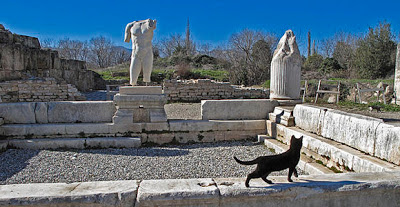APOTHEOSIS OF AELIUS CAESAR
Hadrian adopted Lucius Ceionius Commodus Verus, and called him Aelius Verus Caesar.
It was said that beauty was his only recommendation. His poor health soon overtook him and Hadrian is reported to have said, "We have leaned against a tottering wall and have wasted the four hundred million sentences which we gave to the populace and the soldiers on the adoption of Commodus."
He died on the Calends of January in the year 138 -- only a few months before Hadrian -- from an overdose of medicine given to help him make a speech to the Senate thanking Hadrian for the succession.
After Aelius Caesar's death, Hadrian adopted Antoninus Pius (September 19, 86 - March 7, 161) on the condition that Antoninus Pius adopt the younger Lucius Verus and Hadrian's great-nephew by marriage, Marcus Aurelius (April 26, 121 - March 17, 180).
Marcus later co-ruled with Lucius as Marcus Aurelius until Lucius' death in 169, at which time he was sole ruler until his own death in 180. Collectively, they are remembered as the Antonine Dynasty of emperors who ruled wisely over a period noted for its peace and prosperity.
In his classic text The History of the Decline and Fall of the Roman Empire, 18th Century historian Edward Gibbon considers the reign of the Antonines, as well as those of their predecessors Nerva, Trajan and Hadrian, the height of the Roman Empire, after which time the empire began its inexorable decline.
Aelius Caesar is a major character in Marguerite Yourcenar's epic historical novel Mémoires d'Hadrien (Memoirs of Hadrian).
Lucius, as we affectionately call him, is the recipient of much bittersweet love and adoration from followers of the Religion of Antinous.
For us he represents so many pretty young men whose bright futures are thwarted by tragic illness.
Aelius Caesar is often called the Western Favorite, because of the possibility that he rivaled Antinous for Hadrian's love.
We venerate Aelius Caesar as the fallen Prince of Flowers, the spiritual twin brother of Antinous whose death is the end of the Saturnalia.



















